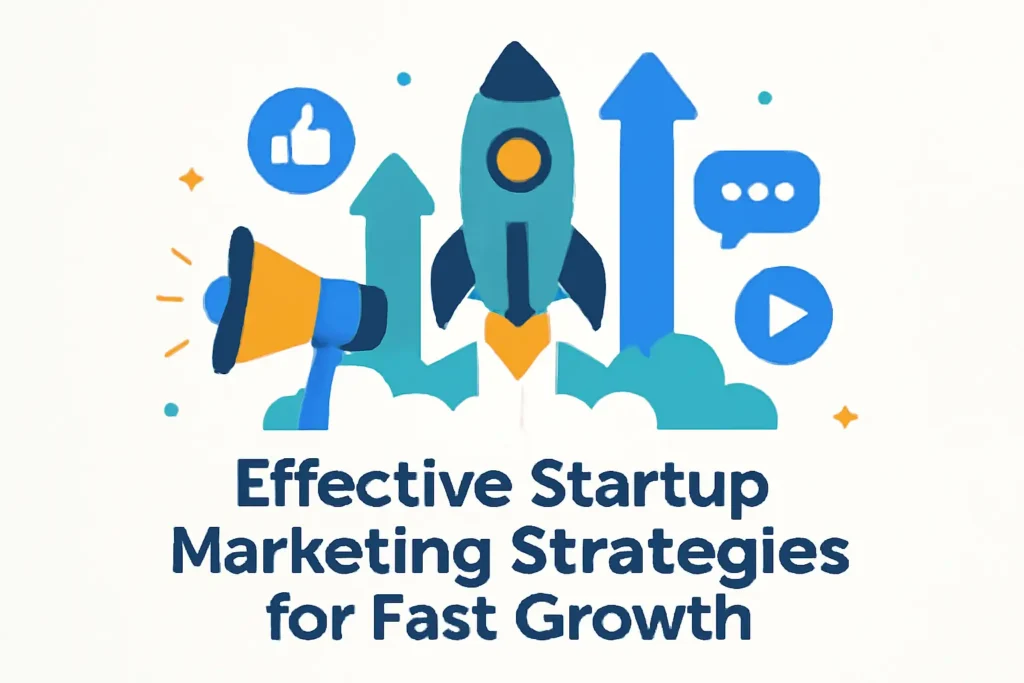Success in the startup world isn’t just about building an incredible product—it’s about getting that product in front of the right people, fast. With fierce competition and limited resources, choosing the right Startup Marketing Strategies can be the difference between hockey-stick growth and being buried in obscurity. Whether you’re launching your MVP this week or battling for your Series A, let’s break down what works, what doesn’t, and how to approach marketing for fast, sustainable growth.

Why Strategic Marketing Is Essential for Startups
Startups face a unique set of challenges: unknown brand, constrained budgets, and the urgent need to prove traction to investors and customers alike. Marketing at this stage isn’t about big budgets—it’s about focus, agility, creativity, and smart experimentation.
Core startup marketing objectives:
- Achieve product-market fit
- Build brand awareness and trust
- Drive user acquisition and retention
- Optimize customer journey for growth
1. Laser-Focused Positioning & Messaging
Know Your Audience
Identify and obsess over your early adopters. Who feels the problem you solve most acutely? Develop an Ideal Customer Profile (ICP) and craft your value proposition with surgical precision. Your messaging should answer: “Why YOU, and why NOW?”
Tips:
- Conduct in-person interviews and user surveys
- Analyze competitors’ audiences and gaps
- Craft buyer personas and adapt as feedback rolls in
Sharp, Consistent Branding
From your logo to your tone of voice, make sure every touchpoint reflects a cohesive, memorable identity. Consistency builds trust and recognition—so don’t fudge the basics.
2. Build Trust Before Traffic
The fastest-growing startups don’t just “get clicks.” They build trust by showcasing transparent proof that their solution works. Before you scale ads or content:
- Collect testimonials and case studies from early users
- Share stories of how your product solves real problems
- Highlight user numbers, awards, or media mentions—even if modest
3. Content and Inbound Marketing: The Long Game
SEO-Driven Content
Publishing SEO-optimized blogs, guides, and landing pages can bring a consistent stream of high-intent visitors—but it takes time. Research relevant keywords (especially long-tail), answer real customer questions, and create content that genuinely helps your audience.
Startup Tip: Even if you’re strapped for time, document your learnings and problems you’re solving for your users. “Building in public” as a founder attracts attention and credibility.
Social Proof and Virality
Actively encourage user reviews, ratings, and shares. Word of mouth remains the ultimate growth engine: build viral features into your product (think referral codes, “Share with a friend” incentives, or simple social sharing tools).
4. The Multi-Channel Approach (But Start Narrow)
Don’t spread yourself too thin. Instead, find one core channel that consistently drives results. Experiment broadly at first, then double-down:
- Social Media: Engage and interact authentically, particularly where your target audience spends time
- Email Marketing: Use targeted drip campaigns for lead nurturing and onboarding
- Content Partnerships: Guest posts, cross-promotions, and integrations with adjacent startups expand reach fast
- Paid Ads: Start small, measure relentlessly, and use paid acquisition to supplement—not replace—organic traction
5. Growth Hacking and Virality
“Growth hacking” isn’t a gimmick—done right, it means embedding marketing into your product. Dropbox gave extra storage for referrals; Hotmail appended “PS: Get your free email at Hotmail” to outgoing emails, fueling fast exponential growth.
Ideas:
- Integrate shareable elements or “Built With” badges
- Gamify onboarding or referral flows
- Measure and iterate on the “viral coefficient”—how many new users each existing user brings in
6. Data-Driven and Agile Experimentation
“Fail fast, learn faster.” Test hypotheses across channels, track performance rigorously, and reallocate budget swiftly to what delivers the best ROI. Use analytics to monitor user acquisition, activation, referral, and retention rates—the “AARRR” (Pirate Metrics) framework is your friend here.
7. Community and Networking
Startups that invest in building communities—be it on Slack, Discord, LinkedIn, or IRL—multiply their word of mouth, get direct feedback, and find partners and beta users. Don’t neglect:
- Hosting webinars or AMAs
- Speaking at meetups and online forums
- Building relationships with industry media and influencers
8. The Power of PR and Thought Leadership
A well-placed feature in TechCrunch or a shoutout by a respected founder can supercharge your startup’s growth. Develop story angles that highlight your mission, traction, or unique solution—and pitch them to journalists and bloggers early on. Don’t be afraid to leverage founders’ personal brands.
Case Studies: Startup Marketing in Action
1. Dropbox’s Referral Engine
- Each user referral earned extra free storage
- Result: Viral coefficient above 1.0; explosive, scalable growth
2. BuzzSumo’s Content Marketing Playbook
- Delivered in-depth content on “content marketing” itself—winning the audience they wanted to sell to
- Leveraged integrations and partnerships with Moz and Buffer
- Grew from launch to $5M ARR in 3 years
3. SEMrush’s Affiliate Program
- Offered compelling commissions to power-users
- Focused on multi-lingual, global SEO for organic traction
- Hundreds of millions in ARR from grassroots efforts
Keeping It Real: Pitfalls & Lessons From Experience
- Don’t try to occupy every channel at once—resource dilution is real
- Avoid vanity metrics (likes and follows); focus on conversion and retention
- Never sacrifice customer trust for short-term PR wins
- Always incentivize feedback loops; listen, adapt, improve
Actionable Takeaways
- Clarify your target audience and product-market fit before pushing big campaigns
- Build trust with social proof and community, even before ramping up paid spend
- Pick one marketing channel to master at a time to avoid scattergun efforts
- Measure everything, iterate rapidly, and double-down on what works
- Lead with value—share your learnings and become part of your users’ daily story
In conclusion: Fast startup growth isn’t magic—it’s the product of relentless customer understanding, focused experiments, community-led trust, and a willingness to double-down on what actually works. The best Startup Marketing Strategies channel scarce resources into high-impact storytelling and rapid learning, propelling startups not just to grow, but to last.
Let your marketing be as innovative as your product, and remember: speed favors those who listen, learn, and adapt fastest.
Read: 10 Lead Generation Strategies That Win Leads for Your Small Business





